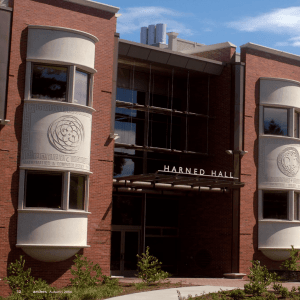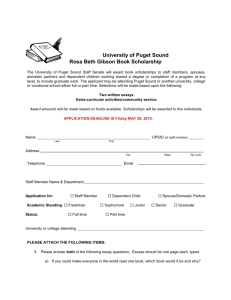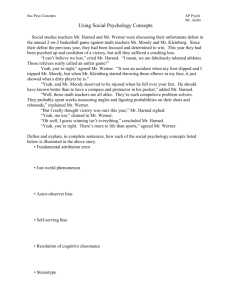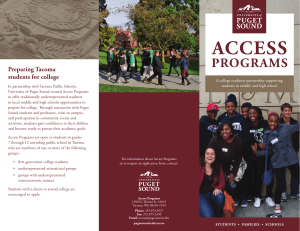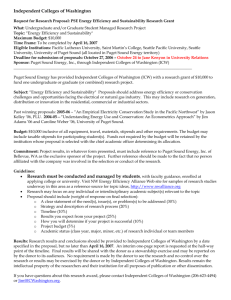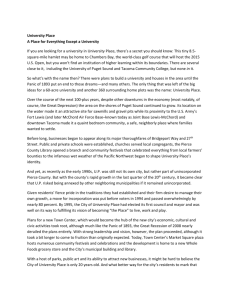University of Puget Sound Announces Dedication of Harned Hall
advertisement
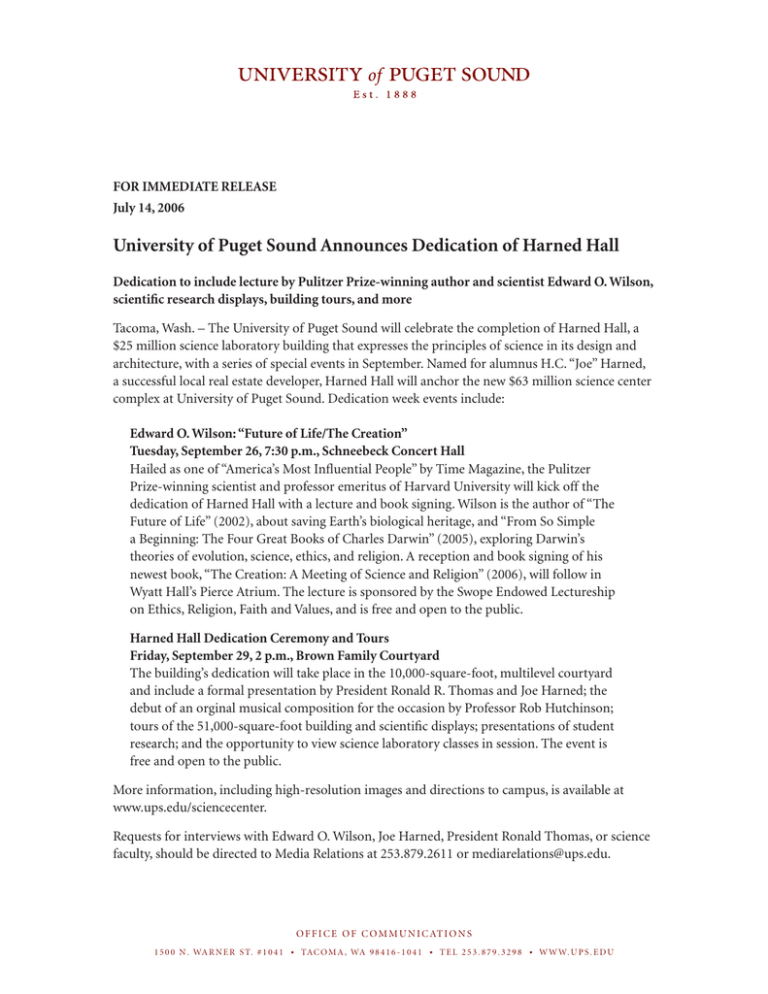
FOR IMMEDIATE RELEASE July 14, 2006 University of Puget Sound Announces Dedication of Harned Hall Dedication to include lecture by Pulitzer Prize-winning author and scientist Edward O. Wilson, scientific research displays, building tours, and more Tacoma, Wash. – The University of Puget Sound will celebrate the completion of Harned Hall, a $25 million science laboratory building that expresses the principles of science in its design and architecture, with a series of special events in September. Named for alumnus H.C. “Joe” Harned, a successful local real estate developer, Harned Hall will anchor the new $63 million science center complex at University of Puget Sound. Dedication week events include: Edward O. Wilson: “Future of Life/The Creation” Tuesday, September 26, 7:30 p.m., Schneebeck Concert Hall Hailed as one of “America’s Most Influential People” by Time Magazine, the Pulitzer Prize-winning scientist and professor emeritus of Harvard University will kick off the dedication of Harned Hall with a lecture and book signing. Wilson is the author of “The Future of Life” (2002), about saving Earth’s biological heritage, and “From So Simple a Beginning: The Four Great Books of Charles Darwin” (2005), exploring Darwin’s theories of evolution, science, ethics, and religion. A reception and book signing of his newest book, “The Creation: A Meeting of Science and Religion” (2006), will follow in Wyatt Hall’s Pierce Atrium. The lecture is sponsored by the Swope Endowed Lectureship on Ethics, Religion, Faith and Values, and is free and open to the public. Harned Hall Dedication Ceremony and Tours Friday, September 29, 2 p.m., Brown Family Courtyard The building’s dedication will take place in the 10,000-square-foot, multilevel courtyard and include a formal presentation by President Ronald R. Thomas and Joe Harned; the debut of an orginal musical composition for the occasion by Professor Rob Hutchinson; tours of the 51,000-square-foot building and scientific displays; presentations of student research; and the opportunity to view science laboratory classes in session. The event is free and open to the public. More information, including high-resolution images and directions to campus, is available at www.ups.edu/sciencecenter. Requests for interviews with Edward O. Wilson, Joe Harned, President Ronald Thomas, or science faculty, should be directed to Media Relations at 253.879.2611 or mediarelations@ups.edu. O F F I C E O F C O M M U N I C AT I O N S 1 5 0 0 N . WA R N E R S T. # 1 0 4 1 ◆ TA C O M A , WA 9 8 4 1 6 - 1 0 4 1 ◆ TEL 253.879.3298 ◆ W W W. U P S . E D U About Harned Hall Designed to meet the U.S. Green Building Council’s LEED Silver standards, using sustainable materials and adhering to stringent environmental guidelines, Harned Hall facilitates the contemporary study of science and encourages even greater interaction among faculty and students, particularly at the intersection of various scientific disciplines. The building includes laboratory spaces for the study of biology, chemistry, environmental science, geology, and physics, and accommodates an increase in science majors researching projects both in the laboratory setting and in fieldwork throughout Puget Sound. A key feature of the building is Science on Display, where creative demonstrations and artistic representations of the principles of science, mathematics, and technology are employed throughout the building. Adjoining Thompson Hall, the university’s original science building, Harned Hall creates a 10,000square-foot courtyard that encompasses a teaching garden with plant species native to the Pacific Northwest and a crystalline glass gazebo offering café service and Fair Trade coffee to the campus community and the general public. Completion of Harned Hall represents the first phase of the design of a comprehensive science center. The next phase includes major renovations to 110,000-square-foot Thompson Hall, which houses classrooms, lecture halls, meeting spaces, and the Slater Museum of Natural History. Thompson Hall renovations are scheduled to be completed in 2008. About University of Puget Sound University of Puget Sound is a 2,600-student independent national undergraduate liberal arts college in Tacoma, Wash., drawing students from 47 states and 13 countries. Puget Sound graduates include Rhodes and Fulbright scholars, notables in the arts and culture, entrepreneurs and elected officials, and leaders in business and finance locally and throughout the world. A low student-faculty ratio provides Puget Sound students with personal attention from faculty who have a strong commitment to teaching and offer 1,200 courses each year in more than 40 major fields. Puget Sound is the only nationally ranked independent undergraduate liberal arts college in Western Washington, and one of just five independent colleges in the Northwest granted a charter by Phi Beta Kappa, the nation’s most prestigious academic honorary society. Nestled in the middle of a residential community, the 99-acre campus enjoys breathtaking views of Mt. Rainier and its namesake Puget Sound. -0Contact: Melissa Rohlfs Media Relations Manager 253.879.2611 mediarelations@ups.edu www.ups.edu/sciencecenter Harned Hall Fact Sheet Dedication Ceremony: Friday, September 29, 2006, 2 p.m., Brown Family Courtyard. Tours of the building will follow from approximately 2:45 to 4 p.m. Location: Union Avenue at North 17th Street, on the west side of the University of Puget Sound campus in Tacoma, Washington. Size: 51,000-square-foot science laboratory building joined to Thompson Hall to create the comprehensive Science Center at University of Puget Sound. The building includes 64,788 bricks, 676,000 pounds of steel, and 9,625 square feet of windows. Investment: $25 million, part of a $63 million investment in the Science Center at Puget Sound. Environment: Designed and built to meet the U.S. Green Building Council’s LEED Silver Rating, using sustainable materials and adhering to stringent environmental guidelines. Occupants: Laboratory spaces and support areas for biology, chemistry, environmental science, geology, and physics. Science on Display: New building features include incorporation of scientific principles in the building’s design and architecture. See “Science on Display” at www.ups.edu/sciencecenter. Courtyard: The joining of Harned Hall to the existing Thompson Hall creates a 10,000-squarefoot multilevel courtyard, containing a research garden, water feature, study and gathering spaces, and a dramatic glass gazebo café. Donors: The building is named for H.C. “Joe” Harned ’51, a resident of Puyallup, Wash., successful commercial real estate developer, and University of Puget Sound alumnus. More than 600 individuals and foundations have contributed to the project, including The Kresge Foundation and The M.J. Murdock Charitable Trust. Architects: SRG Partnership of Portland and Seattle Contractors: Sellen Construction Seattle Contact: Melissa Rohlfs Media Relations Manager 253.879.2611 mediarelations@ups.edu More information, including high-resolution images and directions to campus, is available at www.ups.edu/sciencecenter. O F F I C E O F C O M M U N I C AT I O N S 1 5 0 0 N . WA R N E R S T. # 1 0 4 1 ◆ TA C O M A , WA 9 8 4 1 6 - 1 0 4 1 ◆ TEL 253.879.3298 ◆ W W W. U P S . E D U Harned Hall Science on Display In addition to being a place where science is taught and researched, Harned Hall demonstrates scientific principles in the design and architecture of the building itself. At every turn, visitors to Harned Hall will encounter science on display: Each brick in the courtyard proves a mathematical theory. Each decorative mosaic demonstrates nature’s order. Each artistic rendering of a biological, mechanical, or environmental principle integrates the teaching and learning experience for students, faculty, and visitors alike. Examples include: Juvenile Gray Whale: Above the dramatic three-story entry to Harned Hall hangs the skeleton of a 27-foot-long juvenile gray whale that was beached near the mouth of the Columbia River while migrating north from Baja, Calif. Foucault Pendulum: A Foucault Pendulum demonstrating the rotation of the earth is located in the center of the spiral staircase in Harned Hall’s main lobby. Hung from the ceiling of the third floor, the cable pendulum is suspended over a base of inlaid wood in the penrose pattern, designed by Professor of Physics Alan Thorndike. Analemma: Installed in the entryway of the main lobby is an analemma that tracks the sun’s position in order to determine the date and time. Extending all the way to the third floor, the figure-eight shaped installation plots the path of the sun throughout the year. The analemma was conceived by physics professors Alan Thorndike and Jim Evans. Sierpinski’s Carpet: One of the largest Science on Display installations lies in the pattern of the bricks in the courtyard. The Sierpinski’s Carpet pattern begins with one square, divided into nine congruent squares in a 3-by-3 grid. The center square is then removed. The procedure is applied to the eight remaining squares and repeated infinitely. The resulting design was first described by Warclaw Sierpinski (1882–1969), a Polish mathematician, after whom the pattern was named. Sierpinski’s Carpet is classified as a fractal—a shape that appears similar at all scales of magnification. Mosaics: A glass-walled colonnade runs the length of Harned Hall’s eastern wall, overlooking the courtyard and entry to Thompson Hall. Mounted on the interior wall of the colonnade are two mosaics divided in half by the floor of the building’s third story. Constructed of 4-inch square tiles, the mosaics are artistic representations of the golden rectangle (a logarithmic spiral) and the orbits of the planets in our solar system around the sun inscribed over an aerial view of Puget Sound. Exterior Facade of Harned Hall: The exterior facade of Harned Hall contains embedded representations of the atoms that make up the heavy elements; a Celtic depiction of the Tree of Life, representing a renewable source of sustenance, shelter, and fuel; a spirograph pattern, created when the relative motion of Earth and Venus are charted; and the Greek Key, an ornamental design in Classical art and architecture that relates to the folding pattern of proteins. More information, including high-resolution images and directions to campus, is available at www.ups.edu/sciencecenter. O F F I C E O F C O M M U N I C AT I O N S 1 5 0 0 N . WA R N E R S T. # 1 0 4 1 ◆ TA C O M A , WA 9 8 4 1 6 - 1 0 4 1 ◆ TEL 253.879.3298 ◆ W W W. U P S . E D U Harned Hall Named for H.C. “Joe” Harned ’51 Alumnus, Philanthropist, Commercial Real Estate Developer July 14, 2006 – Joe Harned, who earned a degree in business from University of Puget Sound, is a resident of Puyallup, Wash., and a successful commercial real estate developer. His naming gift to the university is the largest single building gift to Puget Sound in its 118-year history. In addition to his donations to the new science building, Mr. Harned has also established an endowed scholarship fund at University of Puget Sound. “Joe Harned’s commitment to University of Puget Sound, especially to scholarship students and the new Science Center, has a tremendous impact on the quality of the educational experience the university provides,” said President Ronald R. Thomas. “The university is honored to be among the institutions that Mr. Harned has so generously supported.” Puget Sound area development projects in which Mr. Harned has been involved include Azalea Gardens, an active senior community in Graham; development of Tacoma’s 85,000-square-foot Lincoln Plaza and the former General Cinema’s Lincoln Plaza Cinema; and development of Carlyle Court, a community of primarily low-income housing in Lakewood. He played a key role in bringing Costco to Tacoma in 1984, and assisted with the store’s two Tacoma-area relocations. “I was born in 1917, and my family didn’t have much in those days,” said Mr. Harned. “But I always had a desire to improve my own existence. Thanks to the education I earned at University of Puget Sound, as well as a good dose of frugality and determination, I’m pleased to be able to give back to the school. It’s exciting for me to be part of the Science Center project and I look forward to having many future doctors, nurses, and researchers pass through Harned Hall on their way to making positive changes in the world.” Although Tacoma became his home, Mr. Harned’s generosity extends well beyond the Puget Sound region. He has never forgotten his roots in Ursina, Penn. Recognizing that the community struggles economically and not many of its young people can afford to attend college or trade school, he established an endowed scholarship at the Community Foundation of the Alleghenies to provide critically needed financial aid. He also built a new worship center for his hometown church, the United Community Church of God. More information, including high-resolution images and directions to campus, is available at www.ups.edu/sciencecenter. Contact: Melissa Rohlfs Media Relations Manager 253.879.2611 mediarelations@ups.edu O F F I C E O F C O M M U N I C AT I O N S 1 5 0 0 N . WA R N E R S T. # 1 0 4 1 ◆ TA C O M A , WA 9 8 4 1 6 - 1 0 4 1 ◆ TEL 253.879.3298 ◆ W W W. U P S . E D U Harned Hall THE SCIENCE CENTER AT UNIVERSITY OF PUGET SOUND Print-quality images of these and other photographs are available at www.ups.edu/x11757.xml PHOTO CREDIT: ROSS MULHAUSEN © 2006 UNIVERSITY OF PUGET SOUND A view from inside the glass gazebo café that anchors the courtyard between Harned and Thompson halls. Above: A spirograph pattern charted by the relative motion of Earth and Venus is embedded on the front facade of Harned Hall. Right: H.C. “Joe” Harned ’51. A two-story mosaic depicts the orbits of the planets over an aerial view of Puget Sound. Professor Alan Thorndike installs the Foucault pendulum’s base of inlaid wood in a penrose pattern. Sierpinski’s Carpet pattern demonstrated in courtyard paving.
